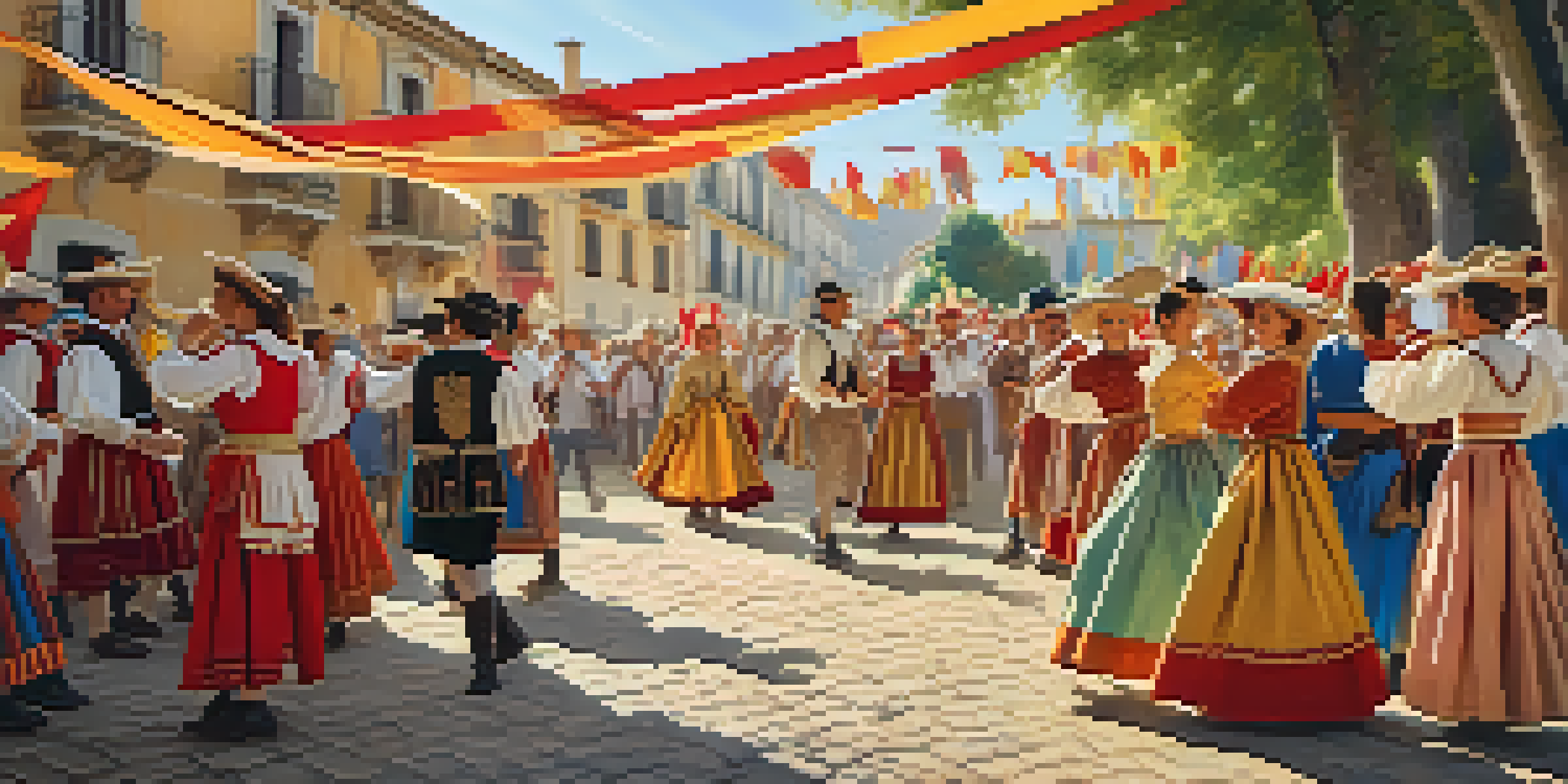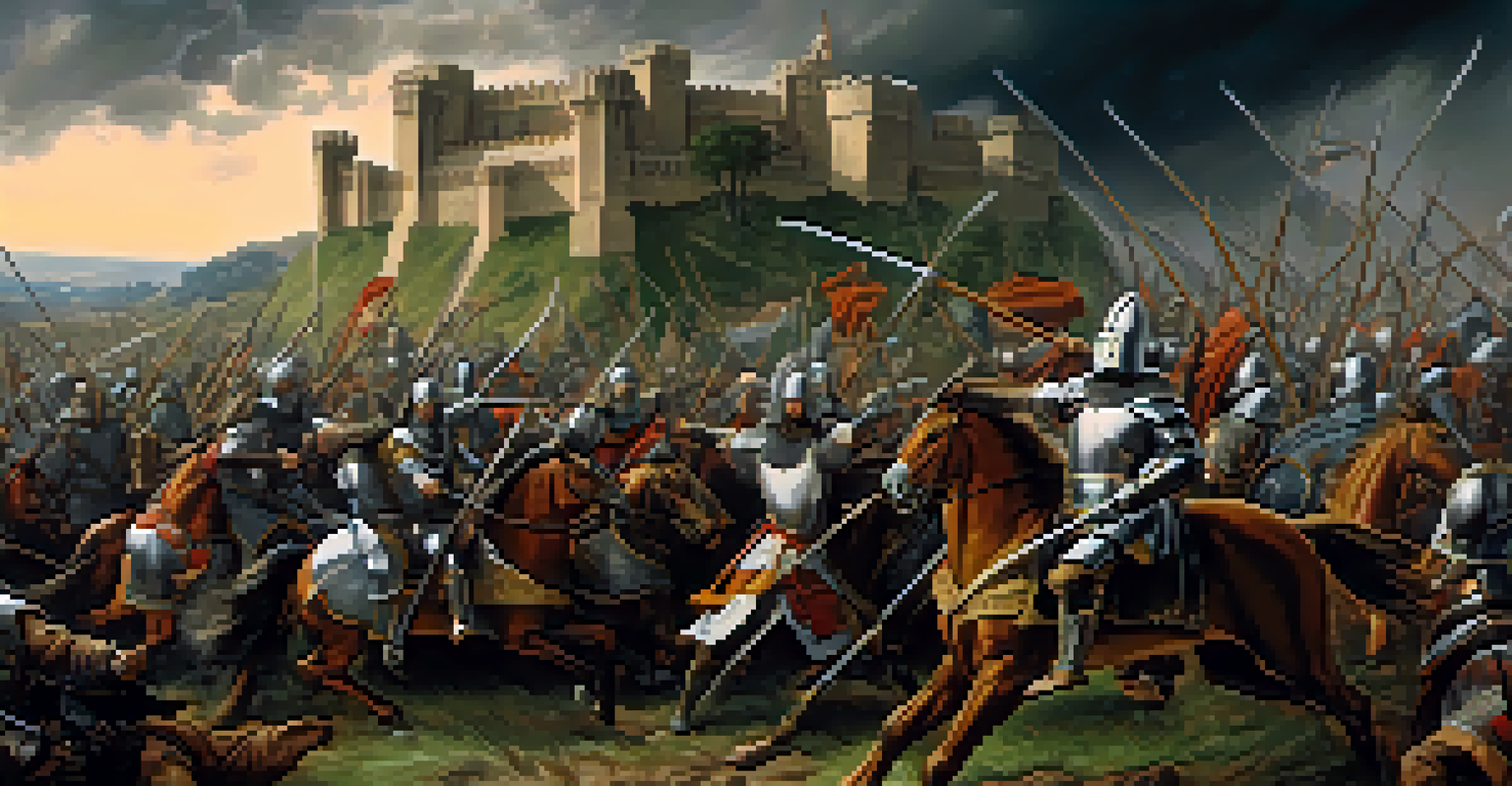The Significance of the Reconquista in Spain's Historical Reenactments

The Reconquista: A Brief Overview of Its Historical Context
The Reconquista was a pivotal period in Spanish history, spanning nearly 800 years, during which Christian kingdoms sought to reclaim territory from Muslim rule. This long struggle began in the early 8th century and culminated in 1492 with the fall of Granada. Understanding this timeline helps us appreciate the cultural and religious transformations that occurred throughout Spain. The legacy of this era is deeply woven into the fabric of Spanish identity.
History is not a burden on the memory but an illumination of the soul.
Throughout the Reconquista, various battles and alliances shaped the political landscape of the Iberian Peninsula. Each victory and loss not only altered territorial boundaries but also influenced social dynamics among Christians, Muslims, and Jews. The complex relationships forged during these times are still reflected in modern Spanish culture, from language to cuisine. Thus, the significance of the Reconquista extends beyond mere military conquests; it represents a profound transformation of a nation.
This historical backdrop sets the stage for why the Reconquista remains a focal point in Spain's reenactments today. These events are not just retellings of battles; they are explorations of identity, heritage, and the ongoing dialogue about coexistence. By reenacting the Reconquista, participants engage with their history, fostering a deeper understanding of their roots and the diverse influences that have shaped Spain.
The Role of Historical Reenactments in Cultural Preservation
Historical reenactments serve as a living museum, allowing participants and spectators to experience history firsthand. In Spain, these events breathe life into the stories of the past, making them accessible to a broader audience. They provide a platform for individuals to connect with their heritage, fostering pride in their cultural identity. The passion displayed during these reenactments can be contagious, encouraging others to learn more about their history.

Moreover, reenactments often involve extensive research and collaboration among historians, actors, and community members. This collaborative effort ensures that the portrayals remain as accurate as possible while still being entertaining. For instance, participants might don period-specific costumes, use historically accurate weapons, and even replicate traditional cooking methods from the Reconquista era. Such attention to detail not only enhances the experience but also educates the public about the significance of the events being reenacted.
Reenactments Preserve Cultural Heritage
Historical reenactments of the Reconquista help keep Spanish cultural identity alive by allowing communities to connect with their shared history.
By immersing themselves in the past, participants in these reenactments contribute to a collective memory that transcends generations. This preservation of culture is essential, especially in a world where globalization can dilute unique traditions. Through reenacting the Reconquista, Spaniards reaffirm their historical narrative and ensure that the stories of their ancestors continue to resonate with future generations.
Community Engagement and the Reconquista Reenactments
Community engagement plays a vital role in the success of historical reenactments. Local festivals and events centered around the Reconquista often attract families, tourists, and history enthusiasts, fostering a sense of togetherness. These gatherings not only celebrate heritage but also promote dialogue among diverse groups, reflecting the multicultural aspects of Spain's past. The shared experience of reenacting history can strengthen community bonds and create lasting memories.
The past is never dead. It's not even past.
In many towns, reenactments become annual traditions, drawing larger crowds each year. Participants, ranging from seasoned reenactors to curious newcomers, often work together to recreate significant battles or cultural events from the Reconquista. This collaborative spirit encourages teamwork and shared learning, making the experiences more enriching for everyone involved. The excitement of witnessing history come alive can inspire a newfound interest in local history and culture.
Moreover, these events often include educational components, such as workshops, lectures, and guided tours. This not only enhances understanding but also invites reflection on the complexities of the Reconquista. As communities come together to celebrate their shared history, they also confront the narratives of conflict, coexistence, and cultural exchange that define their identity. This nuanced exploration is what makes reenactments both engaging and meaningful.
Theatrical Elements in Reconquista Reenactments
Theatrical elements play a crucial role in bringing the past to life during Reconquista reenactments. From dramatic battle scenes to traditional dance performances, these reenactments often resemble theatrical productions. Participants embrace roles that allow them to express the emotions and motivations of their historical counterparts, creating a captivating experience for the audience. This blend of education and entertainment ensures that history is not only informative but also engaging.
Costumes and props are meticulously crafted to reflect the era accurately, adding authenticity to the performances. Reenactors may spend months preparing their outfits, studying historical records to ensure they represent the period faithfully. This attention to detail helps to transport the audience back in time, evoking a sense of connection to the past. The visual spectacle of these events, combined with the passion of the performers, creates a memorable experience that resonates with attendees.
Community Engagement Strengthens Bonds
Local festivals centered around Reconquista reenactments foster community togetherness and promote dialogue among diverse groups.
Furthermore, the incorporation of music and storytelling enhances the overall atmosphere of the reenactments. Traditional songs and tales from the Reconquista era are often woven into the performances, enriching the narrative and providing context. This artistic approach not only entertains but also educates the audience about the cultural significance of the period. Theatrical elements serve as a bridge between the past and the present, making history accessible and relatable.
The Educational Value of Reconquista Reenactments
Reenactments of the Reconquista offer substantial educational benefits for participants and audiences alike. Through firsthand involvement, reenactors gain a deeper understanding of the historical events, social structures, and cultural practices of the time. This immersive experience fosters a greater appreciation for the complexities of the past, encouraging critical thinking and discussions around themes of conflict, identity, and coexistence. Such insights are invaluable for anyone wishing to grasp the nuances of Spanish history.
Additionally, these events often serve as informal learning environments for spectators, especially children and young adults. By witnessing history in action, they can engage with it in ways that textbooks may not provide. Interactive activities, such as archery demonstrations or workshops on traditional crafts, allow participants to experience aspects of life during the Reconquista. This hands-on approach to education makes learning fun and memorable, igniting curiosity about history.
Moreover, educators often utilize reenactments as teaching tools in schools. By incorporating these events into their curricula, teachers can inspire students to explore historical themes in a dynamic way. This educational synergy between schools and community reenactments highlights the importance of preserving and sharing cultural heritage. Through these collaborative efforts, the legacy of the Reconquista continues to be relevant and impactful in contemporary education.
Challenges Faced in Reenacting Historical Events
While celebrating history through reenactments is rewarding, it also presents unique challenges. One significant issue is the accuracy of the portrayal; balancing entertainment with authenticity can be tricky. Reenactors must navigate the fine line between dramatization and factual representation to avoid misinforming audiences. This responsibility requires extensive research and a commitment to portraying history with integrity.
Another challenge is the potential for controversy surrounding sensitive subjects. The Reconquista involved complex interactions between different cultures, and reenacting these events may sometimes evoke strong emotions. Discussions about representation, inclusivity, and historical narratives are essential to ensure that all voices are acknowledged. Addressing these challenges head-on allows reenactors to foster a respectful environment where history can be discussed openly.
Education Through Immersive Experiences
Reenactments serve as interactive learning opportunities, enabling participants and spectators to engage with history in a memorable way.
Finally, logistical concerns, such as funding and venue availability, can impact the quality and frequency of reenactments. Community support and collaboration are crucial in overcoming these hurdles. By rallying local businesses, organizations, and volunteers, communities can create successful reenactments that honor their history while also engaging a wider audience. These efforts emphasize the importance of teamwork in preserving cultural heritage.
The Future of Reconquista Reenactments in Spain
As Spain continues to evolve, so too does the practice of reenacting the Reconquista. New generations of reenactors bring fresh perspectives and innovative ideas, ensuring that these events remain relevant and engaging. This evolution often involves incorporating modern themes or addressing contemporary issues, allowing participants to connect the past with the present. The adaptability of these reenactments reflects the dynamic nature of cultural heritage.
Moreover, the rise of digital technology presents exciting opportunities for reenactments. Virtual reality experiences, online workshops, and social media engagement can broaden the reach of these events, attracting a more diverse audience. By leveraging technology, reenactors can create interactive experiences that educate and entertain, even beyond the confines of physical events. This innovation is crucial in keeping history alive for future generations.

Ultimately, the future of Reconquista reenactments lies in their ability to foster community, educate, and encourage dialogue about Spain's multifaceted history. As long as there is a passion for preserving cultural heritage, these events will continue to thrive. By embracing both tradition and innovation, Spain can ensure that the legacy of the Reconquista remains a vibrant part of its cultural narrative.